
Remembering Virgil Abloh: A Final Conversation With The Late American Fashion Designer
“Everything I Do Is For The 17-Year-Old Version Of Myself”
The death of fashion and design visionary Virgil Abloh from cardiac angiosarcoma, a rare cancer, has left the world’s creative communities in shock. “We are devastated to announce the passing of our beloved Virgil Abloh,” a post on the designer’s official Instagram said. “He chose to endure his battle privately since his diagnosis in 2019, undergoing numerous challenging treatments, all while helming several significant institutions that span fashion, art, and culture. Through it all, his work ethic, infinite curiosity, and optimism never wavered. Virgil was driven by his dedication to his craft and to his mission to open doors for others and create pathways for greater equality in art and design. He often said, ‘Everything I do is for the 17-year-old version of myself,’ believing deeply in the power of art to inspire future generations.”
Having trained as an architect, Abloh threw down a gauntlet to the fashion industry with the launch of Off-White in 2013, before assuming the role of Men’s Artistic Director at Louis Vuitton in 2018, becoming one of the few Black designers to lead a major Parisian fashion house. “Virgil was not only a genius designer, a visionary, he was also a man with a beautiful soul and great wisdom,” Bernard Arnault, the chairman of LVMH Moët Hennessy Louis Vuitton, said in a statement.
Credited with redefining the notion of the modern fashion designer and the parameters of fashion itself, the 41-year-old’s talents extended to DJing, artwork and furniture design. His ability to unite voices across the cultural spectrum saw him collaborate with the likes of Nike, IKEA and Mercedes-Benz, as well as iconic figures in the world of music – designing the album covers for Kanye West and Jay-Z’s joint album Watch the Throne, as well as West’s My Beautiful Dark Twisted Fantasy, part of a long-standing relationship with the rapper.
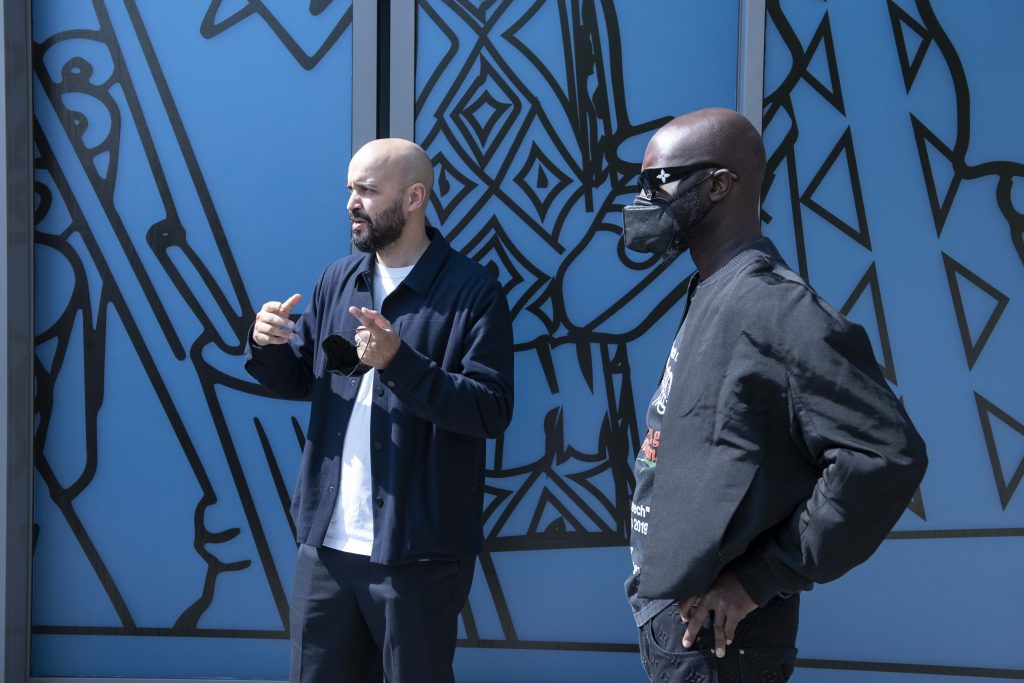
Sharing a photo of Abloh on his Instagram page, Pharrell Williams described the designer as “a kind, generous, thoughtful creative genius. Your work as a human and your work as a spiritual being will live forever.” Hailey Bieber, who wore a custom Off-White wedding dress designed by Abloh at her 2019 wedding to Justin Bieber, called him “A once in a generation creative mind”, whilst youth poet laureate, Amanda Gorman, who once wore a custom look created by Abloh and inspired by his grandmother, wrote “I knew I was experiencing the honor of wearing a designer whose work transcends both past and present. To rephrase something you once said, let us paint new pictures where the old ones have been erased.”
It was only a few short weeks ago [at the time of writing] that Abloh had arrived in Qatar to mark the opening of Virgil Abloh: “Figures of Speech” at Doha’s Fire Station; his first museum exhibition in the Middle East, presented as part of the Qatar-United States 2021 Year of Culture, and one which presents an in-depth look at Abloh’s diverse and pioneering media practice across visual arts, music, fashion, architecture and design. Featuring more than 55 works, and curated by Michael Darling in collaboration with the Museum of Contemporary Art, Chicago and Samir Bantal from AMO/OMA, the exhibition had been billed as a mid-career retrospective—but “Figures of Speech” isn’t grounded in the past. Less about looking back and more about appreciating the present, the works on display—whether a rug created in collaboration with IKEA in 2019 or his “Illinois Institute of Technology Master’s Thesis Building” cityscape designed as part of his Master’s degree in Architecture – were part of a conversation and journey that had led the designer and artist to arrive at this moment. Defying chronology, wherever “Figures of Speech” takes us, Virgil Abloh is resolutely and defiantly grounded in the ‘now’.
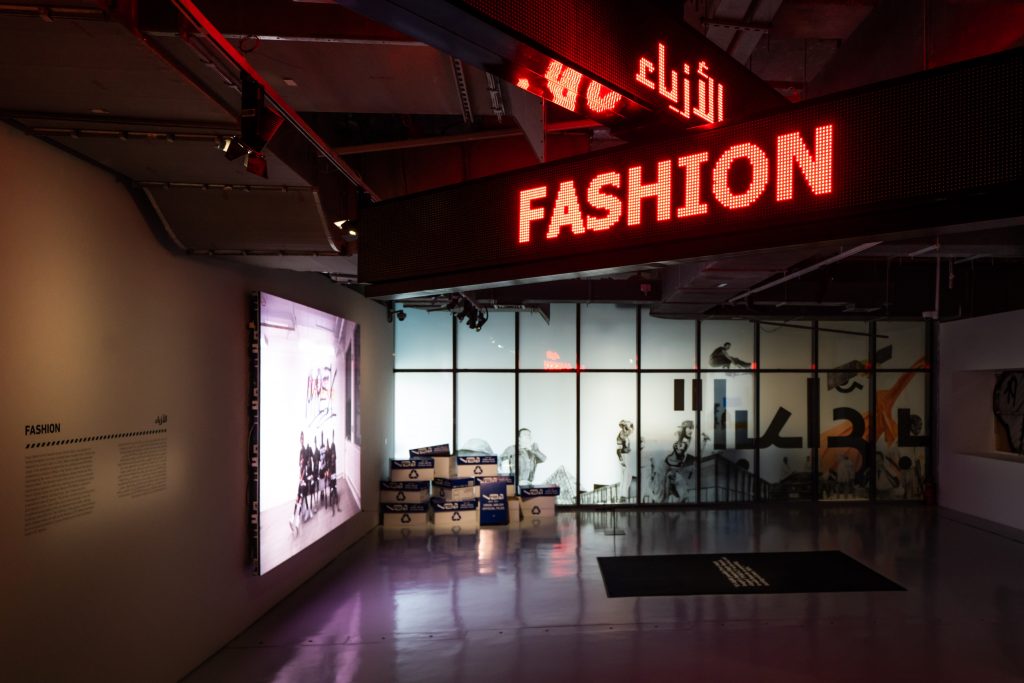
That sentiment finds its affinity in the curation of the exhibition. “When we started working on the show, the initial idea was to present it in chronological order,” says curator Samir Bantal. “But we realised it was much more interesting to talk about the network that Virgil moves between – fashion, music, art, design, and architecture. That kind of fluidity was actually much more important than a simple chronological overview of the work because not only do you have a sense of the disciplines he’s able to navigate through, but also, at the same time, an understanding of a network within a network in terms of creating collaborations with thinkers, artists, writers, and designers. He uses his own skills as a passport through all these different disciplines, and so the show is built up from different chapters – we have the Early Work, Fashion, Streetwear, Music, Black Gaze, Design, and The End [a section of the exhibition that presents recent works that are emblematic of Abloh’s practice of critiquing the influence of advertising]. As you walk through, you start to see things that return, networks that exist – and because of that setup, it can actually continue to grow over time.”
“The key, as Samir was saying, is the community,” continued Abloh. “That’s the underpinning of the research – this community that I foster, but also represent; this generation of creators that are cross-disciplinary. It goes into the first works for Louis Vuitton – the T-shirts made for the guests to wear at the first fashion show [as Artistic Director, Menswear], all in a rainbow array, a crowd mixed together, so that all the colours combined.”
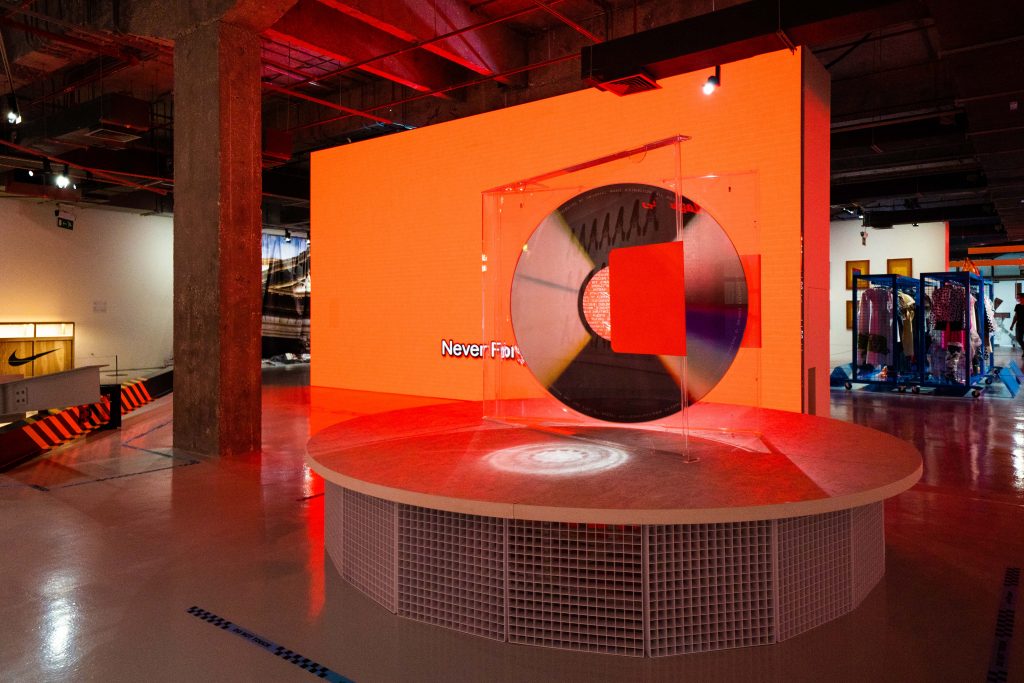
The choice of Doha’s Fire Station as the host venue – a contemporary art space committed to supporting artists through its residence scheme as well as engaging the local communities in Qatar with an inventive range of public programmes—lends itself to the energy, creativity and feeling of nowness that underwrites the exhibition. Museums, one might have imagined of the highly driven Abloh, are not designed to be static buildings. He continued to navigate ahead of the curve (the Black Gaze gallery, for example, was envisaged several years before Black Lives Matter but grapples with many ideas at the heart of the movement), and viewers see this pioneering spirit play out in ‘making of’ elements; prototypes as well as finished artworks, attributing the exhibition with the quality of feeling both done and undone. First organised by the Museum of Contemporary Art Chicago, the exhibition has toured High Museum of Art in Atlanta and the ICA Boston, but Doha has its own unique flavour, aided by the first-ever showing of two new works – Abloh’s Inflatable Bouncy Castle and the customized Mercedes G-Wagon.
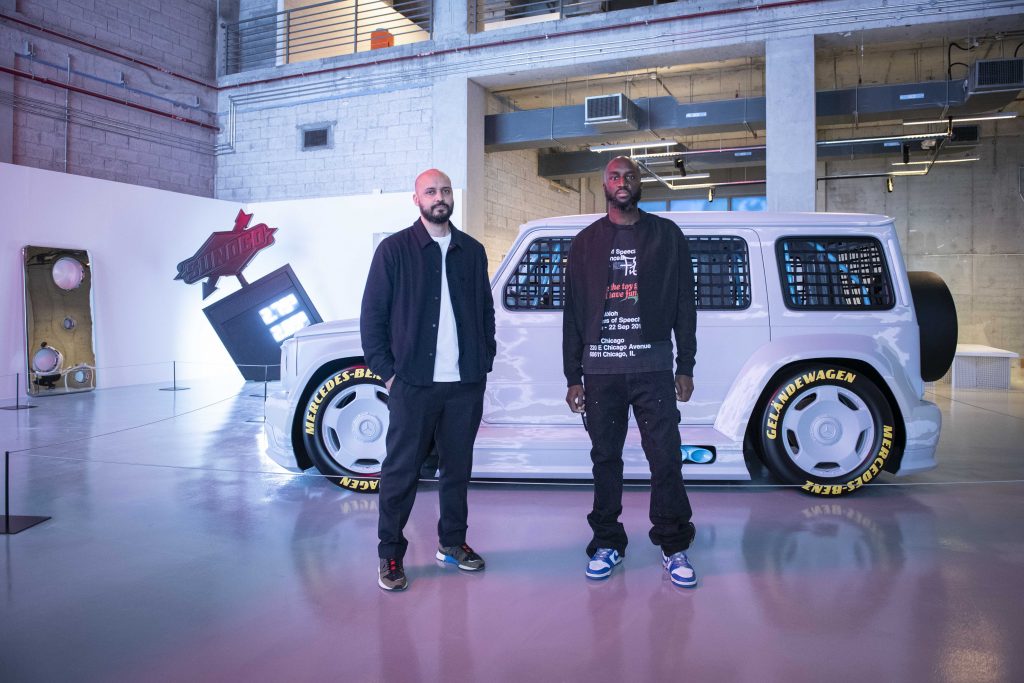
Abloh’s distinctive voice rings out in Early Work, a gallery in which viewers encounter “A Team With No Sport” (2012); a video Abloh made to promote his Pyrex Vision brand. In the video, black youth wear sweatshirts and T-shirts that Abloh has printed with the words “Pyrex 23.” Pyrex refers to the glassware used in home drug labs and 23 refers to the number worn by legendary basketball player Michael Jordan. “This work was pivotal in my career in terms of mixing disciplines,” Abloh explained. “It wasn’t a fashion project, it was more about capturing in film the youth energy in New York that would one day influence fashion. It’s the idea that fashion and identity aren’t about the clothes, they are about the comradery and what’s happening amongst the new generation.” Despite the Pyrex Vision line selling out in minutes, the critical response after the film debuted was less favourable, branding the pieces as too expensive. “So this starts to bring into play the question of what is valuable,” Abloh said. “Were they too expensive because of my ethnicity? Were they too expensive because of my point of view?” One of the write-ups that contextualised the film, by critic Jian DeLeon for Four Pins, argued that ‘It’s entirely possible Pyrex simply bought a bunch of Rugby flannels, slapped ‘PYREX 23’ on the back, and re-sold them for an astonishing mark-up of about 700%.’ Abloh’s response was to print the DeLeon quote on a large black rug, which forms part of the exhibition. “We created this rug as a figurative way to deal with the critical response,” Abloh said. “There is always a barrier to create, there’s always going to be someone telling you that you’ve gone too far. That’s what this whole exhibit is – it’s about existing, doing things differently, challenging the norm.” As for the art critic? “I’m friends with him to this day, he has one of the rugs in his office. I sent it to him.”

Throughout the exhibition, and throughout his career, Abloh explored the notion of “purist and tourist”; those that are part of the institution – the art historians, the critics – and those who remain outside of it but are excited by art, music and fashion and can see themselves within it. “When it comes to critical responses,” he said, “I’m asking the question do these things matter? They matter a lot but they also don’t matter at all. A body of work that exemplifies and investigates that, was my practice 20 years ago and still is today.”
Whilst the different galleries are divided into the aforementioned chapters, there is a distinctive thread of continuity running through each so that “Figures of Speech” has the feel of a jigsaw puzzle in which each gallery is a piece required for the viewer to form a complete picture. Streetwear and its relationship to the subcultures of hip-hop and skateboarding finds its way into Fashion and Music – the latter section featuring album covers and curated Off-White show soundtracks. “The way my practice is set up is sort of like a lexicon – one work creates more work and then creates different outlets. So the sonic contribution, the music for the score, was meticulously made to give context to my work. What you see here [pointing to a custom transparent CDJs and mixer created in collaboration with Pioneer DJ] is the first of its kind ever produced. The sound you are hearing is the soundtrack from consecutive Off-White shows, curated to give context to the work that audiences would see. Just before the fashion shows started, you would hear these interviews. There’s a power to having a recognised voice rearrange the furniture inside someone’s house before they see a body of work. These voices are source texts, in a way. There are so many barriers within one’s brain that have to be unblocked to see fashion from a different point of view, and I use sound as a means to unlock those barriers.”

That fresh point of view is also evident in a display of gold and platinum paper-clip jewellery created in collaboration with jeweller Jacob Arabo. “An important part of hip-hop culture is jewellery and the representative quality that jewellery has,” Abloh explained. “The paperclip is the most inexpensive, elementary piece, but here it is maximalised, made the most it can be, with pavé stones. Again that’s very much my DNA and signature. It plays with perception, it plays with the ability to see yourself in it. So these works are different iterations on the idea of a paperclip. The paperclip is banal, generic, it’s an object that’s been designed by no specific person, it’s something that’s risen up through humanity, so a deeper layer of the work is an investigation into where design comes from, where art comes from, where hierarchy comes from. I like breaking things down which have a hierarchy.”
Elsewhere too, the experience of viewing the PYREX 23 T-shirts, worn by black kids in Abloh’s film showcased in the Early Work gallery, and the raising of questions around race, privilege and cultural expectations, has a knock-on effect on the Black Gaze gallery – “a body of work,” said Abloh, “that starts to highlight the elephant in the room of being diverse and operating in an ecosystem that traditionally doesn’t represent the voice of the totality.” Here, audiences are greeted with an Inez & Vinoodh advertising campaign image for Louis Vuitton featuring a three-year-old named Alieyth. The young child appears in the Wizard of Oz sweater from the SS19 collection. Wielding significant influence in terms of reflecting and, more importantly, working to promote and change Black cultural experiences in the United States, Abloh’s focus on a young black child in men’s luxury clothing asks us what constitutes adulthood but also delves into questions about perception and expectation around race.
In this same gallery, audiences also encounter a large image of a FaceTime screen on an iPhone, based on an observation by video artist and cinematographer Arthur Jafa that the front facing camera of an iPhone captures how someone else looks at oneself especially in terms of their ethnicity and identity. “There’s something about the way that we’ve been trained by these tools in our hands that’s almost beyond a mirror, beyond a photograph, it’s cultural,” said Abloh of Jafa’s work. “It also touches on the role of technology,” adds Bantal, “and how it is often developed with a certain target group in mind, and is therefore always disconnected to a much wider, more diverse group of people. We’ve all seen the scans of Google recognition or Apple not being able to identify or detect or distinguish people of colour from each other. It’s an interesting form of critique.”
This critique continues with “You’re Obviously in the Wrong Place” (2017), a phrase written in bright neon on a black wall. The quote, originally taken from the film Pretty Woman in which Julia Roberts’ character is excluded from an upscale fashion boutique, encapsulates that sense of exclusion felt by many people of colour –from the fashion industry, from the arts and literary worlds, from the critical canon.
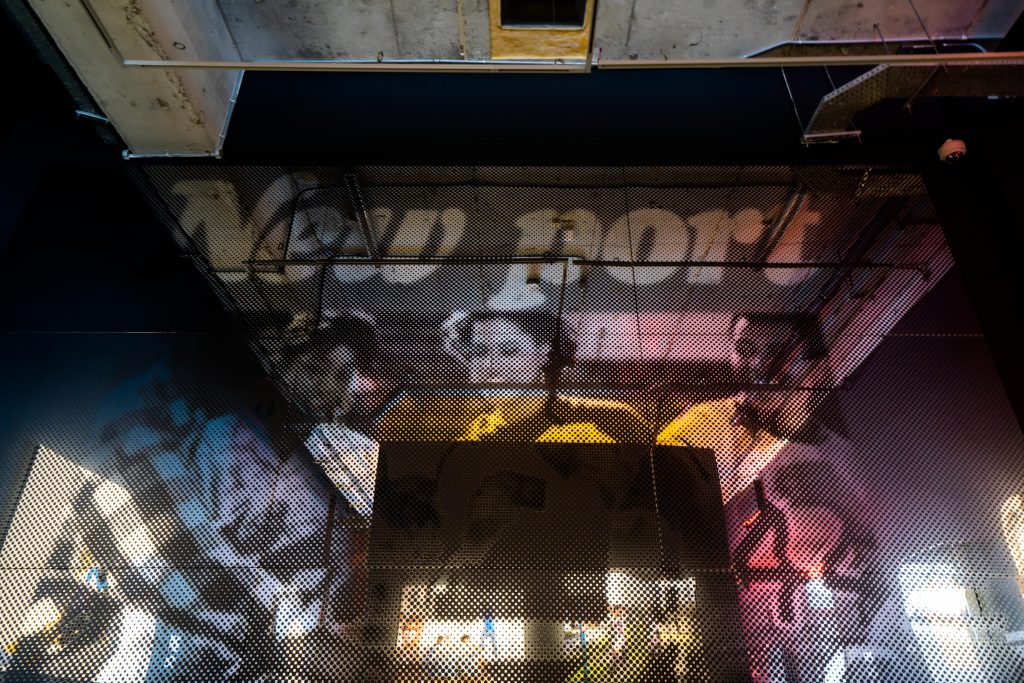
It was exactly that exclusion which Abloh sought to redress – ushering in change not with a whisper, but with a roar; questioning everything and accepting nothing. His was a point of view that saw art as extending past the walls of museums and into the streets; into clothes, sneakers, music, and design. His was a validation that came from a life’s work across disciplines and the tangible response to the dialogue he shaped– remembering “the girl who got out of a car and wanted me to sign her Nikes”. In the courtyard of the Fire Station, a number of large-scale artworks are on display; paying visual testament to that sense of opening up and expanding the reaches of what is possible. As we leave, Abloh was being lifted by crane, holding a can of graffiti spray, to customise an outdoor billboard. It’s how he will be remembered – always creating, never stopping, even when the world had no idea of the battle he was fighting. As Amina Muaddi – presented with the Entrepreneur of the Year award at the Fashion Trust Arabia gala in Doha by Abloh – wrote in tribute following the news of his death, “You’re probably redesigning the gates of Heaven right now. Rest in Power, King.” This may be a retrospective – a chance to pause and take stock of what’s gone before – but Virgil Abloh’s legacy will continue outside of these walls, long after the exhibition has ended, through his family and through the creatives and the community that he has fostered and inspired.
Lead Image courtesy of Alessio Segala
From Harper’s Bazaar Qatar Winter 2021 issue.
